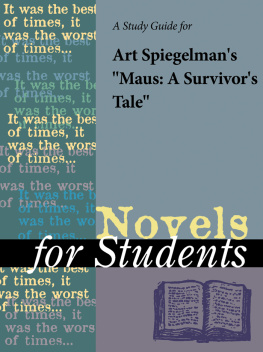TABLE OF CONTENTS
Guide
Novels for Students, Volume 13
Staff
Editor: Elizabeth Thomason.
Contributing Editors: Anne Marie Hacht, Michael L. LaBlanc, Ira Mark Milne, Jennifer Smith, Carol Ullmann.
Managing Editor, Content: Dwayne D. Hayes.
Managing Editor, Product: David Galens.
Publisher, Literature Product: Mark Scott.
Literature Content Capture: Joyce Nakamura, Managing Editor. Sara Constantakis, Editor.
Research: Victoria B. Cariappa, Research Manager. Sarah Genik, Ron Morelli, Tamara Nott, Tracie A. Richardson, Research Associates. Nicodemus Ford, Research Assistant.
Permissions: Maria Franklin, Permissions Manager. Kim Davis, Permissions Associate.
Manufacturing: Mary Beth Trimper, Manager, Composition and Electronic Prepress. Evi Seoud, Assistant Manager, Composition Purchasing and Electronic Prepress. Stacy Melson, Buyer.
Imaging and Multimedia Content Team: Barbara Yarrow, Manager. Randy Bassett, Imaging Supervisor. Robert Duncan, Dan Newell, Luke Rademacher, Imaging Specialists. Pamela A. Reed, Imaging Coordinator. Leitha Etheridge-Sims, Mary Grimes, David G. Oblender, Image Catalogers. Robyn V. Young, Project Manager. Dean Dauphinais, Senior Image Editor. Kelly A. Quin, Image Editor.
Product Design Team: Pamela A. E. Galbreath, Senior Art Director. Michael Logusz, Graphic Artist.
Copyright Notice
Since this page cannot legibly accommodate all copyright notices, the acknowledgments constitute an extension of the copyright notice.
While every effort has been made to secure permission to reprint material and to ensure the reliability of the information presented in this publication, Gale Research neither guarantees the accuracy of the data contained herein nor assumes any responsibility for errors, omissions, or discrepancies. Gale accepts no payment for listing; and inclusion in the publication of any organization, agency, institution, publication, service, or individual does not imply endorsement of the editors or publisher. Errors brought to the attention of the publisher and verified to the satisfaction of the publisher will be corrected in future editions.
This publication is a creative work fully protected by all applicable copyright laws, as well as by misappropriation, trade secret, unfair competition, and other applicable laws. The authors and editors of this work have added value to the underlying factual material herein through one or more of the following: unique and original selection, coordination, expression, arrangement, and classification of the information. All rights to this publication will be vigorously defended.
Copyright 2002
Gale Group
27500 Drake Rd.
Farmington Hills, MI 48331-3535
All rights reserved including the right of reproduction in whole or in part in any form.
ISBN 0-7876-4896-5
ISSN 1094-3552
Printed in the United States of America.
10 9 8 7 6 5 4 3 2 1
The Remains of the Day
Kazuo Ishiguro
1988
Introduction
Kazuo Ishiguro's third novel, The Remains of the Day, earned the 1989 Booker Prize, England's highest literary honor. The book is, in effect, a character study of Stevens, an aging butler who has spent thirty years in service at Darlington Hall. As he considers his past, he is forced to come to terms with the gravity of the sacrifices he has made in the name of duty.
Ishiguro's first two novels were set in Japan, so The Remains of the Day represents a departure in the author's work. Still, it is consistent with his writing style in that the book is told from a first-person point of view by a person who faces past self-deception and regret. Further, the tone is controlled, the language is carefully crafted, and the themes revolve around the position of the individual within a society. While some critics maintain that although Ishiguro's setting is not Japan, the book retains a strong sense of the author's Japanese heritage, Ishiguro is quick to disagree. He responds by saying that most of his life experience has taken place in England and that his fictional influences are Britain's writers. Ishiguro's choice of subject matter in this bookand the realism with which he depicts itdemonstrates the importance of England's past and culture to him.
Author Biography
Kazuo Ishiguro was born in Nagasaki, Japan, on November 8, 1954, to Shizuo (an oceanographer) and Shizuko (a homemaker). When he was six, he and his family moved to England where his father was commissioned by the British government to work on a project. Although the family expected to stay only a few years, his father's work kept them there much longer until England had truly become their home. Although Ishiguro and his two sisters attended English schools and had fairly typical English childhood experiences, at home they spoke Japanese and integrated their Japanese roots into their lives. In fact, Ishiguro has said that his interest in writing started as a way to preserve his fading memories of Japan, a country he would not see again until 1989.
Ishiguro earned a bachelor of arts degree with honors in philosophy and literature in 1978, and then completed his master of arts in creative writing at the University of East Anglia in 1980. He worked as a social worker for a number of years (during and after college) until he was able to make a living as a writer. During his years as a social worker, he met Lorna Anne MacDougall, whom he married in 1986. They have a daughter named Naomi, who was born in 1992. Ishiguro's interests include music and the cinema.
Despite his youth, Ishiguro has already built an impressive literary career. Each of his first three novels won awardsthe third, The Remains of the Day won the prestigious Booker Prizeand all five of his novels to date have earned critical acclaim. Ishiguro's novels deal with self-deception, regret, and personal reflection. His narratives are carefully wrought first-person accounts with a controlled tone that does not deter from the speaker's deep soul-searching. Ishiguro is credited, alongside such high-profile writers as Salman Rushdie, with breathing new life into contemporary British fiction. In 1995, Ishiguro was named to the Order of the British Empire for his contributions to literature.
Plot Summary
Prologue: July 1956
Readers are introduced to Stevens, an aging butler who has served Darlington Hall for about thirty years. The house has recently come under the ownership of an American man named Mr. Farraday, after belonging to Lord Darlington's family for two centuries. While Lord Darlington was a reserved English gentleman, Mr. Farraday is a carefree man who likes to banter. Because he will be away for a while, he suggests that Stevens take his car and go on a trip. Stevens agrees, reasoning that he will go see Miss Kenton (the Hall's ex-housekeeper), who has just written a letter to Stevens. Always focused on duty, Stevens hopes to recruit Miss Kenton back to Darlington Hall, where she is needed.





















